Showing Spotlights 1609 - 1616 of 2780 in category All (newest first):
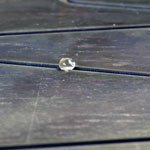 Researchers in Finland and Israel have explored the feasibility of using superhydrophobicity for guided transport of water droplets in microfluidic devices. They demonstrate a new, simple and general approach for transportation of water droplets based on superhydrophobic technology. Water droplets are transported at high velocity in almost totally water-repellent tracks with vertical walls. Drops move in open tracks, machined in metal or silicon wafers, using gravity or using electrostatic charge. Usually, in digital microfluidics, droplets are formed in a system of two immiscible liquids, for example, water in oil, and the liquid volume is transported in microchannels using pumps and valves. In this new approach droplets in air can be used. Employing superhydrophobic tracks, droplets can be transported with low friction and high efficiency.
Researchers in Finland and Israel have explored the feasibility of using superhydrophobicity for guided transport of water droplets in microfluidic devices. They demonstrate a new, simple and general approach for transportation of water droplets based on superhydrophobic technology. Water droplets are transported at high velocity in almost totally water-repellent tracks with vertical walls. Drops move in open tracks, machined in metal or silicon wafers, using gravity or using electrostatic charge. Usually, in digital microfluidics, droplets are formed in a system of two immiscible liquids, for example, water in oil, and the liquid volume is transported in microchannels using pumps and valves. In this new approach droplets in air can be used. Employing superhydrophobic tracks, droplets can be transported with low friction and high efficiency.
Aug 9th, 2011
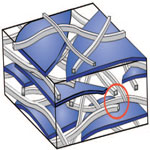 Super-tough materials with exceptional mechanical properties are in critical need for applications under extreme conditions such as jet engines, power turbines, catalytic heat exchangers, military armors, airplanes, and spacecraft. Researchers involved in improving man-made composite materials are trying to understand how some of the amazing high-performance materials found in nature can be copied or even improved upon. Nature has evolved complex bottom-up methods for fabricating ordered nanostructured materials that often have extraordinary mechanical strength and toughness. The main problem in making nanocomposite materials is how the separate components can be interfaced without losing the good properties of each component. Researchers were now able to show that biomolecules that may seem soft and fragile can actually strengthen a composite material by creating cohesion between two materials that differ much from each other.
Super-tough materials with exceptional mechanical properties are in critical need for applications under extreme conditions such as jet engines, power turbines, catalytic heat exchangers, military armors, airplanes, and spacecraft. Researchers involved in improving man-made composite materials are trying to understand how some of the amazing high-performance materials found in nature can be copied or even improved upon. Nature has evolved complex bottom-up methods for fabricating ordered nanostructured materials that often have extraordinary mechanical strength and toughness. The main problem in making nanocomposite materials is how the separate components can be interfaced without losing the good properties of each component. Researchers were now able to show that biomolecules that may seem soft and fragile can actually strengthen a composite material by creating cohesion between two materials that differ much from each other.
Aug 8th, 2011
 Until more information becomes available on the mechanisms underlying nanomaterial toxicity, it is uncertain what measurement technique should be used to monitor exposures in the workplace. Many of the sampling techniques that are available for measuring airborne nano aerosols vary in complexity but can provide useful information for evaluating occupational exposures with respect to particle size, mass, surface area, number concentration, and composition. Unfortunately, relatively few of these techniques are readily applicable to routine exposure monitoring. That's why researchers have now developed a unique new sampler design that collects nanoparticles separately from larger particles in a way that mimics the respiratory system.
Until more information becomes available on the mechanisms underlying nanomaterial toxicity, it is uncertain what measurement technique should be used to monitor exposures in the workplace. Many of the sampling techniques that are available for measuring airborne nano aerosols vary in complexity but can provide useful information for evaluating occupational exposures with respect to particle size, mass, surface area, number concentration, and composition. Unfortunately, relatively few of these techniques are readily applicable to routine exposure monitoring. That's why researchers have now developed a unique new sampler design that collects nanoparticles separately from larger particles in a way that mimics the respiratory system.
Aug 4th, 2011
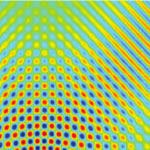 Exotic artificial composite materials called metamaterials can be engineered with certain electromagnetic properties that allows them to act as invisibility cloaks. These materials bend all light or other electromagnetic waves around an object hidden inside a metamaterial cloak, to emerge on the other side as if they had passed through an empty volume of space. Researchers have already been experimenting with cloaking devices for various, usually longer wavelengths such as microwave or infrared waves. Recently, even graphene has been added to the family of cloaking materials. Now, for the first time, a team of scientists at UC Berkeley have devised an invisibility cloak material that hides objects from detection using light that is visible to humans.
Exotic artificial composite materials called metamaterials can be engineered with certain electromagnetic properties that allows them to act as invisibility cloaks. These materials bend all light or other electromagnetic waves around an object hidden inside a metamaterial cloak, to emerge on the other side as if they had passed through an empty volume of space. Researchers have already been experimenting with cloaking devices for various, usually longer wavelengths such as microwave or infrared waves. Recently, even graphene has been added to the family of cloaking materials. Now, for the first time, a team of scientists at UC Berkeley have devised an invisibility cloak material that hides objects from detection using light that is visible to humans.
Aug 3rd, 2011
 Structural color - where the color results from interferences, not pigments - is a natural fit for new display technologies and writing substrates since it can provide vivid colors in environments of high intensity light (e.g. sunlight) without the need for additional illuminating power. Most existing display technologies such as LCDs and LEDs require power to actively project colors and often suffer from performance degradations in these reflective environments. Recognizing this, researchers have developed a number of techniques for dynamically and spatially modulating the colors reflected off of photonic crystal-like substrates. In new work, researchers have demonstrated an electrical-power-free infusion technique that allows them to draw multi-color images on colloidal photonic crystal substrates using transparent imaging oils.
Structural color - where the color results from interferences, not pigments - is a natural fit for new display technologies and writing substrates since it can provide vivid colors in environments of high intensity light (e.g. sunlight) without the need for additional illuminating power. Most existing display technologies such as LCDs and LEDs require power to actively project colors and often suffer from performance degradations in these reflective environments. Recognizing this, researchers have developed a number of techniques for dynamically and spatially modulating the colors reflected off of photonic crystal-like substrates. In new work, researchers have demonstrated an electrical-power-free infusion technique that allows them to draw multi-color images on colloidal photonic crystal substrates using transparent imaging oils.
Aug 2nd, 2011
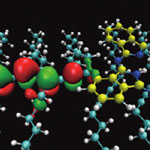 Using single molecules as electronic components like diodes, switches or transistors is the ultimate goal for future electronic nanotechnology devices. In order to explore the electronic properties of a single molecule, researchers have to make electrical contact between electrodes and molecules - and this has proven to be a big challenge. Though many efforts have been made to realize single-molecule electronics, it is still impossible to fabricate a practical single-molecule integrated circuit. One of the problems is the lack of viable methods for wiring each functional molecule. Researchers have now demonstrated a novel method for controlling single molecule chemical reactions - a kind of 'chemical soldering'.
Using single molecules as electronic components like diodes, switches or transistors is the ultimate goal for future electronic nanotechnology devices. In order to explore the electronic properties of a single molecule, researchers have to make electrical contact between electrodes and molecules - and this has proven to be a big challenge. Though many efforts have been made to realize single-molecule electronics, it is still impossible to fabricate a practical single-molecule integrated circuit. One of the problems is the lack of viable methods for wiring each functional molecule. Researchers have now demonstrated a novel method for controlling single molecule chemical reactions - a kind of 'chemical soldering'.
Jul 28th, 2011
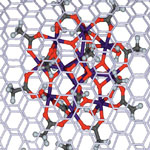 Single-molecule magnets (SMM) are fascinating nanoscale structures with unique functional properties showing promise for high-density electronic data storage devices, solid state quantum computers, spintronic devices such as spin valves, and other advanced technological applications. Despite a flurry of research in this area - since an individual magnetic molecule represents the ultimate size limit to storing and processing information - the main challenge related to harnessing properties of SMM remained unsolved. A new study by a group of European researchers reports the successful encapsulation of single-molecule magnets in carbon nanotubes, yielding a new type of hybrid nanostructure that combines all the key single-molecule magnet properties of the guest molecules with the functional properties of the host CNT.
Single-molecule magnets (SMM) are fascinating nanoscale structures with unique functional properties showing promise for high-density electronic data storage devices, solid state quantum computers, spintronic devices such as spin valves, and other advanced technological applications. Despite a flurry of research in this area - since an individual magnetic molecule represents the ultimate size limit to storing and processing information - the main challenge related to harnessing properties of SMM remained unsolved. A new study by a group of European researchers reports the successful encapsulation of single-molecule magnets in carbon nanotubes, yielding a new type of hybrid nanostructure that combines all the key single-molecule magnet properties of the guest molecules with the functional properties of the host CNT.
Jul 27th, 2011
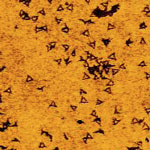 To build microprocessors with more than one billion transistors, manufacturers still use the same technique - photolithography, the high-tech, nanoscale version of printing technology - that they have been using for the past 50 years. State-of-the-art photolithography processes use 193 nm light to produce diffraction-limited features as small as 32 nm. Going beyond 32 nm, the cost and complexity rises significantly, posing massive technological and economic challenges for chip manufacturers. This provides plenty of incentives for researchers to explore alternative manufacturing technologies for chipmakers. One novel approach is based on the use of DNA nanostructures to pattern a silicon wafer.
To build microprocessors with more than one billion transistors, manufacturers still use the same technique - photolithography, the high-tech, nanoscale version of printing technology - that they have been using for the past 50 years. State-of-the-art photolithography processes use 193 nm light to produce diffraction-limited features as small as 32 nm. Going beyond 32 nm, the cost and complexity rises significantly, posing massive technological and economic challenges for chip manufacturers. This provides plenty of incentives for researchers to explore alternative manufacturing technologies for chipmakers. One novel approach is based on the use of DNA nanostructures to pattern a silicon wafer.
Jul 26th, 2011
 Researchers in Finland and Israel have explored the feasibility of using superhydrophobicity for guided transport of water droplets in microfluidic devices. They demonstrate a new, simple and general approach for transportation of water droplets based on superhydrophobic technology. Water droplets are transported at high velocity in almost totally water-repellent tracks with vertical walls. Drops move in open tracks, machined in metal or silicon wafers, using gravity or using electrostatic charge. Usually, in digital microfluidics, droplets are formed in a system of two immiscible liquids, for example, water in oil, and the liquid volume is transported in microchannels using pumps and valves. In this new approach droplets in air can be used. Employing superhydrophobic tracks, droplets can be transported with low friction and high efficiency.
Researchers in Finland and Israel have explored the feasibility of using superhydrophobicity for guided transport of water droplets in microfluidic devices. They demonstrate a new, simple and general approach for transportation of water droplets based on superhydrophobic technology. Water droplets are transported at high velocity in almost totally water-repellent tracks with vertical walls. Drops move in open tracks, machined in metal or silicon wafers, using gravity or using electrostatic charge. Usually, in digital microfluidics, droplets are formed in a system of two immiscible liquids, for example, water in oil, and the liquid volume is transported in microchannels using pumps and valves. In this new approach droplets in air can be used. Employing superhydrophobic tracks, droplets can be transported with low friction and high efficiency.
 Subscribe to our Nanotechnology Spotlight feed
Subscribe to our Nanotechnology Spotlight feed





